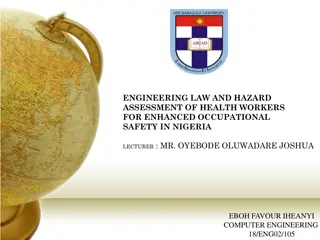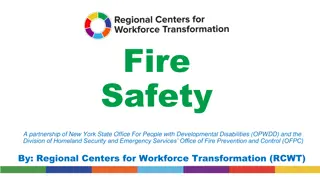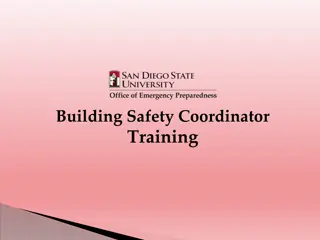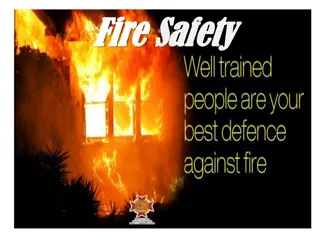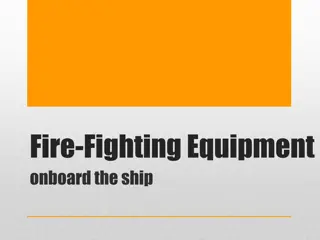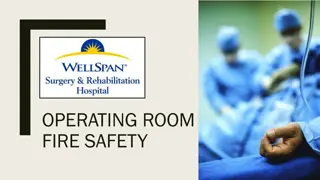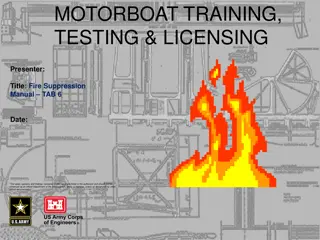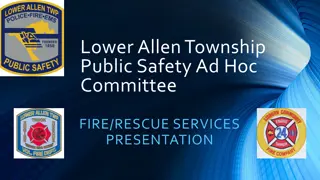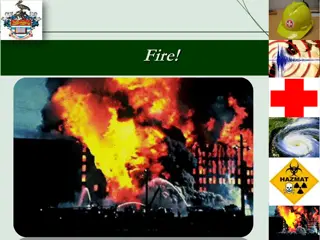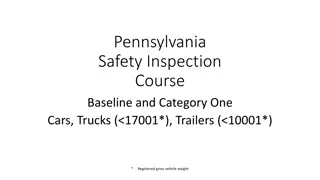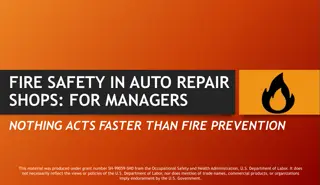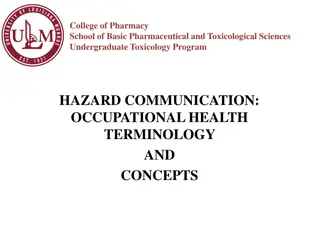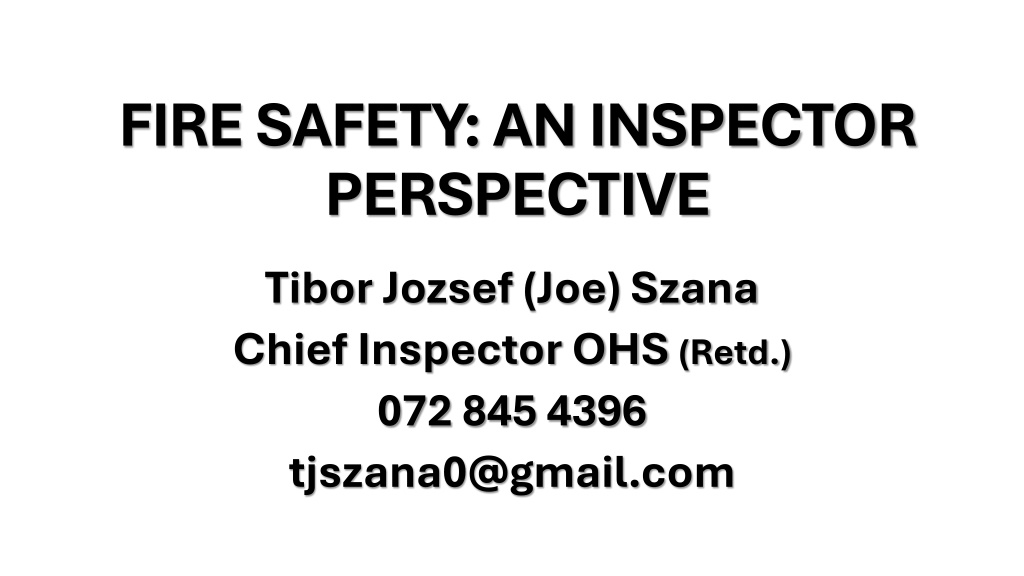
Insight into Fire Safety Inspections and Investigations
Gain valuable insights from an ex-Chief Inspector's perspective on fire safety, including why not every fire is investigated, the involvement of authorities, and the need for improved legislation in the firefighting sector. Understand the types of fires investigated and those that are not, along with potential risks faced by firefighters. Delve into a discussion on the future of firefighting with new technologies and the pros and cons they bring.
Download Presentation

Please find below an Image/Link to download the presentation.
The content on the website is provided AS IS for your information and personal use only. It may not be sold, licensed, or shared on other websites without obtaining consent from the author. If you encounter any issues during the download, it is possible that the publisher has removed the file from their server.
You are allowed to download the files provided on this website for personal or commercial use, subject to the condition that they are used lawfully. All files are the property of their respective owners.
The content on the website is provided AS IS for your information and personal use only. It may not be sold, licensed, or shared on other websites without obtaining consent from the author.
E N D
Presentation Transcript
FIRE SAFETY: AN INSPECTOR PERSPECTIVE Tibor Jozsef (Joe) Szana Chief Inspector OHS (Retd.) 072 845 4396 tjszana0@gmail.com
The first presenter left me depressed and demoralised . The industry sounded like the Titanic.
I just need to remind you that one of the characteristics of serial killers is that they played with fires as a youngster!
Personal Impact My brother Making chips The cobbler - Fire extinguishers at home
Content Background Types of fires that may or may not be investigated Why is every fire not investigated? Past cases Fire Fighters face several OHS risks The future and New Technology Pros and Cons of Future Firefighting In Conclusion
Background What is the level of involvement of the DEL in the event of fires at the workplace . which could of course include your homes. The Department does not investigate every fire that takes place at the workplace or in homes where the suspected cause could have been electrical or gas, etc. This would fall within the ambit of the Provincial and Regional Offices. However, Section 32 does add a twist to it. Some of the fires investigated that are well known includes: Esschem; Johannesburg vacant buildings occupied by illegal occupiers, Old age home(s), etc.
Some may find this debatable . In the event of fires, OHSA would be considered together with its relevant Regulations, however, it should be noted that the current legislation remains hopelessly inadequate to effectively deal with the fire fighting sector and therefore would need to be given attention to going forward.
Fires that will not be investigated could include: Fires caused by arson Veld fires Motor vehicle (EVs) fires especially those caused by batteries.
Types of Fires Investigated: 1. Workplace Fires: Fires that occur in any workplace, including offices, factories, warehouses, and other commercial or industri al settings. Incidents Involving Machinery: Fires that are related to the use of machinery or equipment in the workplace. Accidents Involving Flammable Materials: Fires that involve the handling or storage of flammable and combustible materials. Electrical Fires: Fires caused by faulty electrical equipment or wiring. 2. 3. 4. Types of Fires Not Typically Investigated: 1. Residential Fires: Fires that occur in private homes or residential buildings are generally not investigated by OSH inspectors un less they involve a home-based business. Natural Fires: Wildfires or other natural fire incidents are outside the scope of OSH inspectors and are typically handled by ot her agencies. Vehicle Fires: Fires that occur in vehicles, unless the vehicle is part of a workplace fleet or used for work purposes. Arson: Fires that are intentionally set, especially if they occur in a workplace setting. 2. 3. 4.
Why is it that they do not investigate every fire incident that takes place at work? There is no legislation that allows the DEL to inspect or investigate incidents and to make sure the appropriate measures are in place in managing a fire fighting system as put forward by the SABS 10400. As the SABS 10400 is not fully incorporated it does create a problem. The task of ensuring everything is in place does however rest with the local authority who operates according to their own procedures and systems included in amongst others, their By- Laws. There is however no synergy between the DEL and the Local Authority to ensure compliance.
Summary of the outcome of the investigation into the Lenasia factory fire that occurred in November 2000, resulting in the tragic loss of 11 workers: Trial and Fines: The trial involved the owner of ESS Chemicals, Suleman Lachporia (45), and his manager, Nezahuddin Ahmod (32). The workers were allegedly locked inside the factory when the fire broke out, leading to their deaths. In a plea bargain agreement (a new concept in South Africa at the time), both men were fined by the court: Lachporia was fined R100,000 or five years imprisonment (with five years house arrest, except for work and religious purposes). He also paid R10,000 into the estate of the deceased workers. Ahmod was fined R50,000 (or two years imprisonment) and R40,000 (or 18 months, suspended for five years).
Blame accrued to .. included . The court held that if labor department inspectors had done their duty and inspected the ESS Chemicals premises, the 11 workers might still be alive1.
Postponement and Communication Issues: The trial faced delays due to communication problems between the interpreter and Ahmod, who spoke different dialects. Relatives of the victims expressed disappointment, emphasizing the dire financial impact on their families since the disaster occurred. The charge sheet alleged that the accused failed to provide or maintain a safe working environment for the factory employees. The inherently unsafe production process of manufacturing floor polish was carried out with inflammable liquid close to open flames on the premises1.
Forensic Investigation: A forensic expert investigating the fire noted that evidence had been tampered with by people walking on the scene2. The tragedy highlighted the importance of workplace safety and the need for proper inspections to prevent such incidents. Learn more: 1klasslooch.com2news24.com3iol.co.za
Some of the key challenges related to health and safety risks and contraventions The Paarl Print fire, which occurred on April 17, 2009, in Dal Josaphat, Paarl, South Africa, resulted in the tragic loss of 13 lives. Let s explore some of the key challenges related to health and safety risks and contraventions during this incident: Probable Cause: The most probable cause of the fire was determined to be the auto-ignition of cooking oil in a chip fryer located in the factory canteen. The fire rapidly spread through the ceiling lining of the roof, engulfing the entire plant. Unique Spread of Fire: The fire s extremely rapid and uncontrollable spread was attributed to the ignition of the thermal under-roof insulation material. This unique behavior posed significant challenges for firefighting efforts.
Lack of Preventive Measures: Despite the comprehensive forensic investigation, the fire s origin and rapid spread highlighted gaps in preventive measures. The facility lacked adequate safety protocols and infrastructure to contain or control the fire effectively.
Communication and Evacuation: Communication challenges during the emergency may have hindered evacuation efforts. Firefighters and employees needed clear instructions and efficient communication channels to escape safely. Accountability and Transparency: Families of the victims sought clarity on the cause of the fire and accountability for the tragedy. The report on the investigation was initially withheld, but a court ruling eventually allowed access to the findings.
Lessons for Employers and Unions: Employers and trade unions can learn from this accident to prevent similar incidents in the future. Transparency, safety protocols, and knowledge-sharing are crucial for preventing workplace disasters.
The Paarl Print Factory Fire serves as a somber reminder of the importance of safety protocols and the devastating consequences when they are not followed. Learn more: 1bizcommunity.com2bizcommunity.com3netwerk24.com4iol.co.za5iol.co.za6mg.co.za
Paarl Print Inquiry Report should be made available to all interested parties according to the judgement ..
Firefighters face several health and safety risks
Some of the key challenges they encounter: Cancer: Risk: Smoke and chemicals significantly raise firefighters risk of cancer. Some fire organizations consider this the most dangerous threat to firefighters health. Mesothelioma: Firefighters contract mesothelioma (caused by asbestos exposure) at twice the rate of the general population. Other Cancers: Research suggests higher rates of cancers in the bladder, prostate, lungs, and blood. Cause of Concern: Exposure during firefighting and inadequate cleaning or storage of turnout gear contribute to this risk.
Osteo-arthritis: Risk: Firefighters are at increased risk for osteoarthritis, particularly in the knees and hips. Cause: Frequent squatting, bending (especially while carrying heavy equipment), and joint strain contribute to this condition. Impact: Osteoarthritis tends to worsen over time, leading to general joint pain.
Sleep Disorders: Prevalence: Almost 40% of firefighters suffer from sleep disorders. Health Effects: Chronic sleep loss increases the risk of heart attack, cancer, metabolic disease, stroke, obesity, and depression. Challenges: Firefighters struggle with insomnia, disturbing dreams, and daytime sleepiness. Improvements: Addressing sleep issues deliberately can lead to significant improvements.
Hearing Loss: Cause: Repeated exposure to alarms, sirens, machinery, and other noise at emergency scenes. Risk: Hearing issues can become life-threatening for firefighters, especially when protective gear limits visual perception. Mitigation:Some departments implement hearing conservation programs to reduce noise-induced hearing loss risk.
Of course the elephant in the room .. Psychological issues which is now dealt with by the Ergonomics Regulations here you could be looking at issues of PTSDand other serious mental healthissues.
These health risks underscore the need for better safety protocols and ongoing support for their well-being. 1blog.massgeneralbrighamhealthplan.org2usfa.fema.gov3deohs.washington.edu4firefighterhealthsafety.org
What does the future hold in store then for this sector?
Drones play a crucial role in firefighting efforts by providing valuable data, enhancing situational awareness, and aiding in fire suppression. Here are some ways drones are involved in fighting fires: Aerial Surveillance and Mapping: Drones equipped with cameras and thermal imaging sensors can fly over fire-affected areas, capturing real-time images and videos. These visuals help incident commanders assess the fire s size, spread, and intensity. High-resolution maps generated by drones assist in planning containment strategies and identifying hotspots. Early Detection and Monitoring: Drones can quickly reach remote or inaccessible locations, allowing early detection of wildfires. Continuous monitoring helps track fire behavior, smoke movement, and potential threats to communities. Real-time data from drones informs evacuation decisions and resource allocation.
Fire Behavior Analysis: Thermal cameras on drones detect heat signatures, revealing hidden fires or smoldering areas. Understanding fire behavior (such as spotting, crown fires, and ember showers) guides firefighting tactics. Safety Assessments: Drones assess structural damage, identify hazards, and evaluate the stability of buildings. Firefighters can make informed decisions about entering or avoiding compromised structures.
Aerial Water Delivery: Some drones carry water or fire retardant payloads. They can drop water directly onto flames or create firebreaks by spraying retardant along fire perimeters. Communication Relays: Drones equipped with communication devices extend radio coverage in areas with poor signal. They enhance coordination among firefighting teams and improve safety during operations.
Post-Fire Assessment: After the fire is contained, drones assist in damage assessment and recovery planning. They capture images of affected areas, helping authorities allocate resources for rehabilitation. Remember that drone operations during firefighting must comply with aviation regulations and safety protocols. Drones are valuable tools, but their use requires skilled operators and integration into incident management systems.
Key advancements: their pros and cons: The world of firefighting is evolving rapidly with new technologies and innovations aimed at improving efficiency, saf ety, and effectiveness. Key Advancements in Firefighting 1.Drones and Robotics: Drones and robots are increasingly being used for reconnaissance, search and rescue, and ev en firefighting itself. They can access areas that are too dangerous for humans and provide real- time data to firefighters. Pros: Enhances safety by reducing human exposure to dangerous situations, provides valuable information qui ckly, and can operate in environments that are inaccessible to humans. Cons: High initial costs, potential technical failures, and the need for specialized training to operate and maint ain these technologies.
2.Thermal Imaging Cameras: These cameras help firefighters see through smoke and darkness, allowing them to l ocate hotspots and trapped individuals more effectively. Pros: Improves situational awareness, enhances rescue operations, and increases the safety of firefighters. Cons: Can be expensive, requires training to use effectively, and may not work well in all conditions.
3.Exoskeleton Suits: These suits provide additional strength and support to firefighters, reducing fatigue and the risk of injury. Pros: Increases the physical capabilities of firefighters, reduces the risk of injury, and allows for longer operational periods . Cons: Can be heavy and cumbersome, requires training to use properly, and may be expensive. 4.Real-Time Data and Fog Computing: Utilizing realtime data and fog computing helps firefighters make informed decisions quickly by providing actionable intelligence. Pros: Enhances decision-making, improves resource allocation, and can potentially save lives and property. Cons: Requires robust data infrastructure, can be complex to implement, and may have privacy concerns.
5.Eco-Friendly Fire Suppressants: New fire suppressants are being developed that are less harmful to the environment compared to traditional chemicals. Pros: Reduces environmental impact, safer for humans and wildlife, and can be more sustainable in the long run. Cons: May be less effective in certain situations, higher costs, and potential regulatory hurdles.
In Conclusion . Could the deaths have been avoided .YES! . WITHOUT ANY DOUBT Could the fires have been avoided? .. YES! Could procedures and systems have helped in avoiding deaths and injuries? .. YES! DEFINITELY Could available technology of today 2024 have helped to avoid any of the injuries or deaths? .YES . POSSIBLY Could working equipment and PPE have avoided any of the injuries and/or death YES .. POSSIBLY
REMEMBER . A tick-box of what you need to do in the event of legislation does not exist and if it does IT WILL contain limitations of some sort or the other. A comprehensive risk assessment is undoubtedly key and will only be as good as the team members engaged in the assessment and subsequent risk management plan.
What does the future hold in store then . It is important that the sector ensures that it is formalisedand speaks with one voice. The health and safety component while regulated at the local level still could find itself beholden to the DEL because of OHSwho has the ultimate mandate albeit that at this stage it is rather a minuscule or insignificant portion.
Those who have a direct interest should write to the ACOHS indicating its concern that DEL has not adequately regulated for the sector despite numerous serious incidents.
It should however be made clear that the generalist approach of the legislationstill does carry some wait and employers should still apply themselves to the requirements of OHSA.
THANK YOU Tibor Szana tjszana0@gmail.com 0728544396

